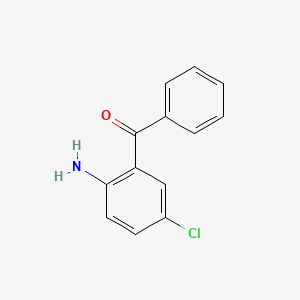
In chemistry, a hexose is a monosaccharide (simple sugar) with six carbon atoms. The chemical formula for all hexoses is C6H12O6, and their molecular weight is 180.156 g/mol.

Mercury(II) cyanide, also known as mercuric cyanide, is a poisonous compound of mercury and cyanide. It is an odorless, toxic white powder. It is highly soluble in polar solvents such as water, alcohol, and ammonia; slightly soluble in ether; and insoluble in benzene and other hydrophobic solvents.
This is the list of extremely hazardous substances defined in Section 302 of the U.S. Emergency Planning and Community Right-to-Know Act. The list can be found as an appendix to 40 CFR 355. Updates as of 2006 can be seen on the Federal Register, 71 FR 47121.
The Blanc chloromethylation is the chemical reaction of aromatic rings with formaldehyde and hydrogen chloride to form chloromethyl arenes. The reaction is catalyzed by Lewis acids such as zinc chloride. The reaction was discovered by Gustave Louis Blanc (1872-1927) in 1923.
Niobocene dichloride is the organometallic compound with the formula (C5H5)2NbCl2, abbreviated Cp2NbCl2. This paramagnetic brown solid is a starting reagent for the synthesis of other organoniobium compounds. The compound adopts a pseudotetrahedral structure with two cyclopentadienyl and two chloride substituents attached to the metal. A variety of similar compounds are known, including Cp2TiCl2.
1,5-Pentanediol is the organic compound with the formula HO(CH2)5OH. Like other diols, this viscous colourless liquid is used as plasticizer and also forms polyesters that are used as emulsifying agents and resin intermediates.

Fluorenol, also known as hydrafinil, is an alcohol derivative of fluorene. In the most significant isomer, fluoren-9-ol or 9-hydroxyfluorene, the hydroxy group is located on the bridging carbon between the two benzene rings. Hydroxyfluorene can be converted to fluorenone by oxidation. It is a white-cream colored solid at room temperature.

Neophyl chloride, C6H5C(CH3)2CH2Cl, is a halogenated organic compound with unusual nucleophilic substitution properties. Neophyl chloride is used to form a versatile organolithium reagent, neophyl lithium, by reaction with lithium.

Stannole is an organotin compound with the formula (CH)4SnH2. It is classified as a metallole, i.e. an unsaturated five-membered ring containing a heteroatom. It is a structural analog of cyclopentadiene, with tin replacing the saturated carbon atom. Substituted derivatives, which have been synthesized, are also called stannoles.

Superphane is a 6-fold bridged cyclophane with all arene positions in the benzene dimer taken up by ethylene spacers. The compound has been of some scientific interest as a model for testing aromaticity and was first synthesised by Virgil Boekelheide in 1979. Superphane is the base compound for a large group of derivatives with structural variations. The analogs with 2 to 5 bridges are also known compounds. The benzene rings have been replaced by other aromatic units, such as those based on ferrocene or stabilized cyclobutadiene. Numerous derivatives are known with variations in the type and length of the bridging units.

Carbophenothion also known as Stauffer R 1303 as for the manufacturer, Stauffer Chemical, is an organophosphorus chemical compound. It was used as a pesticide for citrus fruits under the name of Trithion. Carbophenothion was used as an insecticide and acaricide. Although not used anymore it is still a restricted use pesticide in the United States. The chemical is identified in the US as an extremely hazardous substance according to the Emergency Planning and Community Right-to-Know Act.

Tetramethylxylylene diisocyanate (TMXDI) is an organic compound with the formula C6H4(CMe2NCO)2 (Me = CH3). Introduced in the 1980s by American Cyanamid, the molecule features two isocyanate groups. TMXDI is generally classified as an aliphatic isocyanate, which are generally more UV stable than their aromatic counterparts.

In chemistry, a phenol ether (or aromatic ether) is an organic compound derived from phenol (C6H5OH), where the hydroxyl (-OH) group is substituted with an alkoxy (-OR) group. Usually phenol ethers are synthesized through the condensation of phenol and an organic alcohol; however, other known reactions regarding the synthesis of ethers can be applied to phenol ethers as well. Anisole (C6H5OCH3) is the simplest phenol ether, and is a versatile precursor for perfumes and pharmaceuticals. Vanillin and ethylvanillin are phenol ether derivatives commonly utilized in vanilla flavorings and fragrances, while diphenyl ether is commonly used as a synthetic geranium fragrance. Phenol ethers are part of the chemical structure of a variety of medications, including quinine, an antimalarial drug, and dextromethorphan, an over-the-counter cough suppressant.

(Trimethylsilyl)methyl chloride is the organosilicon compound with the formula (CH3)3SiCH2Cl. A colorless, volatile liquid, it is an alkylating agent that is employed in organic synthesis, especially as a precursor to (trimethylsilyl)methyllithium. In the presence of triphenylphosphine, it olefinates benzophenones:

Hafnocene dichloride is the organohafnium compound with the formula (C5H5)2HfCl2. It is a white solid that is sparingly soluble in some organic solvents. The lighter homologues zirconacene dichloride and titanocene dichloride have received much more attention. While hafnocene is only of academic interest, some more soluble derivatives are precatalysts for olefin polymerization. Moreso than the Zr analogue, this compound is highly resistant to reduction.

Diglycidyl resorcinol ether, also called Resorcinol diglycidyl ether (RDGE) is a liquid aromatic organic chemical compound and chemically a glycidyl ether.
Germanium dichloride dioxane is a chemical compound with the formula GeCl2(C4H8O2), where C4H8O2 is 1,4-dioxane. It is a white solid. The compound is notable as a source of Ge(II), which contrasts with the pervasiveness of Ge(IV) compounds. This dioxane complex represents a well-behaved form of germanium dichloride.
2-Methoxyethoxymethyl chloride is an organic compound with formula CH3OCH2CH2OCH2Cl. A colorless liquid, it is classified as a chloroalkyl ether. It is used as an alkylating agent. In organic synthesis, it is used for introducing the methoxyethoxy ether (MEM) protecting group. MEM protecting groups are generally preferred to methoxymethyl (MOM) protecting groups, both in terms of formation and removal.

2-Amino-5-chlorobenzophenone is a substituted benzophenone that can be used in the synthesis of benzodiazepines.

















